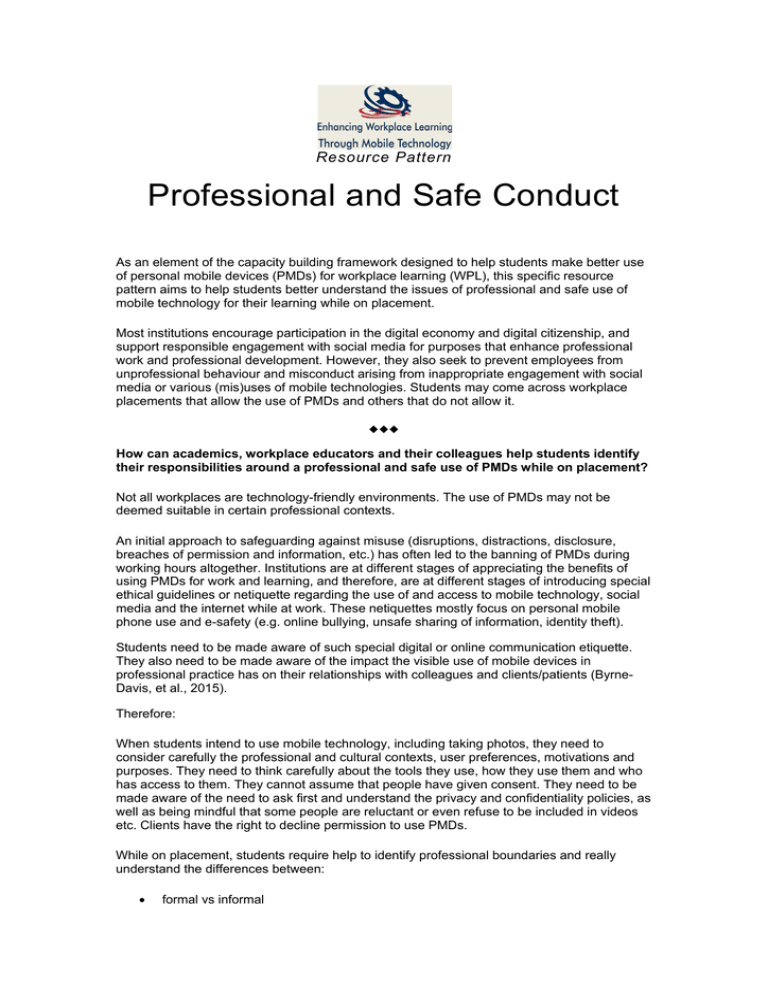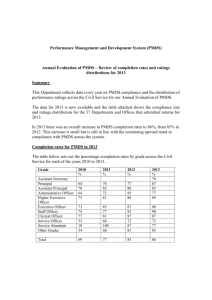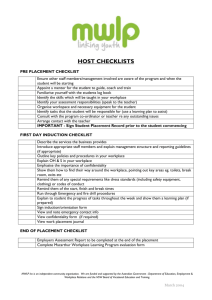Professional and Safe Conduct
advertisement

Resource Pattern Professional and Safe Conduct As an element of the capacity building framework designed to help students make better use of personal mobile devices (PMDs) for workplace learning (WPL), this specific resource pattern aims to help students better understand the issues of professional and safe use of mobile technology for their learning while on placement. Most institutions encourage participation in the digital economy and digital citizenship, and support responsible engagement with social media for purposes that enhance professional work and professional development. However, they also seek to prevent employees from unprofessional behaviour and misconduct arising from inappropriate engagement with social media or various (mis)uses of mobile technologies. Students may come across workplace placements that allow the use of PMDs and others that do not allow it. How can academics, workplace educators and their colleagues help students identify their responsibilities around a professional and safe use of PMDs while on placement? Not all workplaces are technology-friendly environments. The use of PMDs may not be deemed suitable in certain professional contexts. An initial approach to safeguarding against misuse (disruptions, distractions, disclosure, breaches of permission and information, etc.) has often led to the banning of PMDs during working hours altogether. Institutions are at different stages of appreciating the benefits of using PMDs for work and learning, and therefore, are at different stages of introducing special ethical guidelines or netiquette regarding the use of and access to mobile technology, social media and the internet while at work. These netiquettes mostly focus on personal mobile phone use and e-safety (e.g. online bullying, unsafe sharing of information, identity theft). Students need to be made aware of such special digital or online communication etiquette. They also need to be made aware of the impact the visible use of mobile devices in professional practice has on their relationships with colleagues and clients/patients (ByrneDavis, et al., 2015). Therefore: When students intend to use mobile technology, including taking photos, they need to consider carefully the professional and cultural contexts, user preferences, motivations and purposes. They need to think carefully about the tools they use, how they use them and who has access to them. They cannot assume that people have given consent. They need to be made aware of the need to ask first and understand the privacy and confidentiality policies, as well as being mindful that some people are reluctant or even refuse to be included in videos etc. Clients have the right to decline permission to use PMDs. While on placement, students require help to identify professional boundaries and really understand the differences between: • formal vs informal • • • • • • learning vs working public vs private home vs placement real vs virtual anonymous vs identified sharing vs appropriating Individual preferences and organisational acceptance can be better understood by looking at professional bodies and host organisations’ policies and guidelines (what is said about the use of mobile technology), observing and enquiring about informal etiquettes, likes and dislikes (how is mobile technology actually used). From these sayings and doings, students can determine how they can and want to use mobile technology professionally and safely on a particular workplace placement. The following table can help “promote the professional and safe use of mobile technologies” (West & Vosloo, 2013) by helping students unpack the complex layers of explicit and latent uses of PMDs in a host organisation. Table: Professional and Safe Use of PMDs Domains Discipline / Professional body Policies and guidelines Actual use My use Content: Form: Workplace Patients/Clients Workplace educator/supervisor Personal Embellishments: ### Related patterns: ### References Byrne-Davis, L., Dexter, H., Hart, J., Cappelli, T., Byrne, G., Sampson, I., Mooney, J., Lumsden, C. (2015). Just-in-time research: a call to arms for research into mobile technologies in higher education. Research in Learning Technology, 23. West, M., & Vosloo, S. (2013). UNESCO policy guidelines for mobile learning HERDSA Review of Higher Education (Vol. 21, pp. 002196). Paris: UNESCO. Acknowledgement This resource was developed as part of a two-year research project funded by the Australian Government Office for Learning and Teaching. It is a multi- site project led by CSU and conducted in collaboration with The University of Sydney, Western Sydney University and Deakin University.



